SUBFAMILY FORMICINAE - Genus Camponotus
| The Ants of
Africa SUBFAMILY FORMICINAE - Genus Camponotus |
|
| Contents - Formicinae - FORMICINAE Introduction |
In Tribe CAMPONOTINI.
![]() Diagnostic Features -
Polymorphic. Antennae 12-segmented,
inserted some distance behind the posterior clypeal margin. Frontal
carinae converging anteriorly, leaving the antennal insertions only
partially or not at all covered. Eyes present, usually well developed
and situated behind the midlength of the head. Clypeus often with a
median portion projecting as a truncated lobe, more obvious in larger
workers. Mandibles with five to seven stout teeth. Promesonotal suture
distinct, development of other sutures variable. Alitrunk unarmed.
Petiole a node or scale, unarmed. Acidopore circular and clearly
visible.
Diagnostic Features -
Polymorphic. Antennae 12-segmented,
inserted some distance behind the posterior clypeal margin. Frontal
carinae converging anteriorly, leaving the antennal insertions only
partially or not at all covered. Eyes present, usually well developed
and situated behind the midlength of the head. Clypeus often with a
median portion projecting as a truncated lobe, more obvious in larger
workers. Mandibles with five to seven stout teeth. Promesonotal suture
distinct, development of other sutures variable. Alitrunk unarmed.
Petiole a node or scale, unarmed. Acidopore circular and clearly
visible.
Mayr's (1861) genus description is at ![]() .
.
A very large, complex genus, which is taxonomically confused and in great need of revision.
Bernard (1952) wrote of them as very polymorphic, often with several castes of genetically distinct workers; notably among the arboricolous species of South America. Many species were known only from the medium or minor workers, and others, such as Camponotus maculatus, were ubiquitous and excessively variable. Thus, the study of the genus was very tricky, and the main specialists had avoided creating subgenera, without finding any other form of useful sections. Without doubt the sexual stages would prove to be the best natural means of separating species. From Africa 154 species were reported, most from the work of Emery (1925b, in Genera Insectorum), and sections had been created or modified by Santschi (1926c and 1937a). The Mt. Nimba surveys had collected 20 species, of which one seemed truly new; diverse queens and males could not be identified. He gave a few sectional notes, thus -
Section 6 Myrmopelta Santschi 1921, and Emery, 1925 - medium sized, with golden or white hairs on the gaster, mainly western Africa; several feed mainly on termites.
Section 11 Myrmotrema Forel - small to medium sized, gaster matt, with or without dense coloured hairs, antenna more or less deformed, apparently termitophages, 32 species from sub-Saharan Africa.
Section 13 Myrmachraphe Santschi - a group of 10 singular species, with a compressed and humped thorax.
Radoszkowsky (1881) listed Camponotus angolensis F Smith, from Angola, collected by Welwitsch. Bolton (1995: 85) has this as a nomen nudum.
Subgenera known from sub-Saharan Africa
Note the single species still listed in Bolton (1995) as in the subgenus Colobopsis (Camponotus (Col.) bifossus) seems likely to be a Paramyrmamblys and I have placed it there.
| Mayria
Forel (1878: 369) - Gaster extremely long and narrow; petiole narrower
than the base of gaster, slightly narrower behind than in front, and
strongly low; whole body elongated and narrow; petiole with a narrow
node; frontal carinae S-shaped; but set well apart and divergent;
apical segment of antennae slightly swollen. Alitrunk with
paromoseonatla and metanotal sutures distinct but not impressed. True Mayria
(e.g. repens and lubbocki) appear to have a quite
evenly curved propodeum with no longitudinal or transverse impressions;
also the scapes and legs are distinctly flattened. TL majors to 7.5 mm;
minors ca 4.5 mm The Antweb photographs of Madagasar species show that several if not most of those also are not Mayria but Myrmosaga I regard the placement of four species from mainland southern Africa as erroneous and have transferred them to Myrmosaga. No African species |
 |
| Myrmacrhaphe Santschi (1926c: 607) - with compressed and humped thorax, large eyes, major head with transverse occiput; all are black; gaster without abundant pubescence. Ten species known, all West Africa and/or the Congo Basin. All medium sized, largest known majors TL ca 10 mm; minors TL ca 6.5-7.0 mm |  |
| Myrmacrhaphe minor |
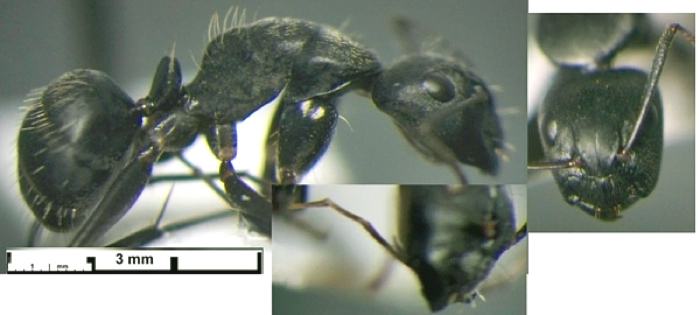 |
| Myrmamblys Forel (1912i: 90) - mostly unsculptured, shiny, thorax of worker moderately low and not medially waisted (étranglé); dimorphism (no intermediates) shown in head, always more or less truncate, including clypeus, antennal insertions well forward relative to frontal carinae, petiole small and squamiform. Minors with anterior of clypeus usually the full width of the head. Major workers use the truncated head to block nest entrances in hollow stems and trunks of trees (Arnold 1924: 613). Four species known. Largest majors TL to 9.3 mm; minors TL ca 4.0-6.0 mm | 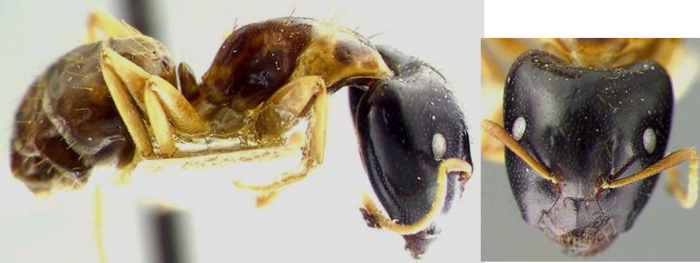 |
| Myrmespera Santschi (1926b: 247) - mandibles somewhat elongated with oblique apices and a large apical tooth subtended by four smaller teeth, head with strongly domed profile; gaster without pubescence. Ten species from east or southern Africa. Medium to large species; majors known with TL 12.0 mm; minors TL from 5.0 mm |  |
| Myrmisolepis Santschi (1921f: 310) - pronotum angular more or less bordered and depressed; clypeus similar in major and minor, separable from Myrmopiromis by metanotal suture not descending full depth of alitrunk; from Myrmotrema in having the mesonotum highly narrowed; petiole scale truncate with the posterior face as convex as the anterior; very short sparse to moderate pubescence on most parts of the body. Five species known, three being from eastern Africa. Medium sized, TL range 5.3-7.0 mm | 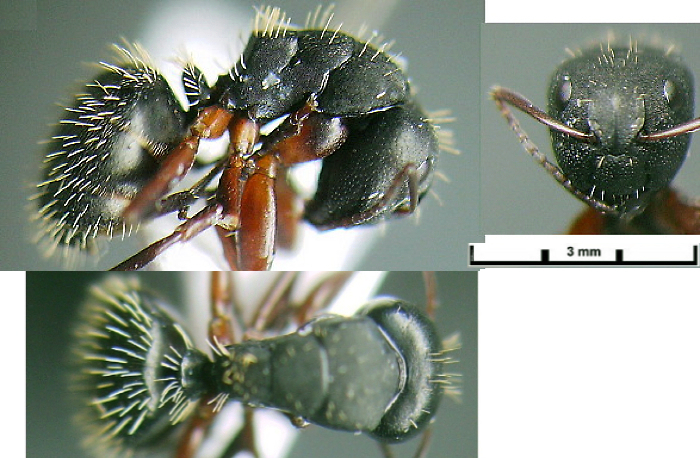 |
| Myrmonesites
Emery (1920b: 242) - new inclusion - alitrunk with incised
metanotal suture, variably domed propodeum and petiole scale ranging
from a thick scale to a quite low dome; clypeus with a rounded anterior
border; generally without pubescence. Minors with somewhat elongated
ovoid heads. Only two species are known from mainland Africa Major TL 7.0-8.2 mm; minors TL 4.7-6 mm |
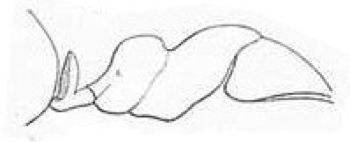  |
| Myrmopelta Santschi (1921f: 310) - medium sized, pronotum neither shouldered or bordered; major with much more elongated head than minor; clypeus flatter and more rectangular in the minor, with the median carina often replaced by a more or less complete frontal notch; propodeum with distinct, often impressed metanotal suture; petiole scale truncate with the posterior face as convex as the anterior; with golden or white hairs on the gaster; pubescence on gaster varies from sparse to dense. Minors with heads essentially the same shape as majors. Five species known. Largest majors TL ca 9-10 mm; minors 5.5-6.0 mm | 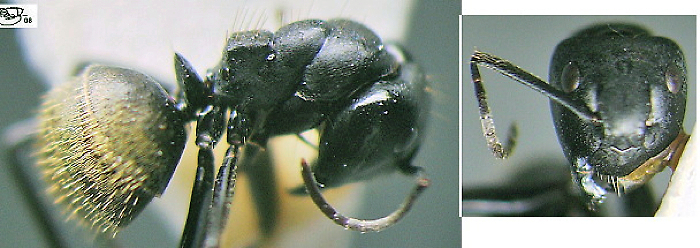 |
| Myrmopiromis Wheeler (1921a: 17) - head as in Orthonotomyrmex, major very broad posteriorly, minor trapezoidal, broadened posteriorly; genae without deep pits on major and queen; most with coarse, fairly abundant, obtuse hairs of a pale colour, sometimes forming a fur-coating on gaster; pubescence on gaster varies from sparse to dense; anterior dorsum of pronotum with distinct margin which may be developed into quite prominent teeth. Seven species known from Eastern & Southern Africa, the single West African record seems likely to be a mis-identification of a Myrmotrema. Majors medium TL ca 7.5-8.0 and large TL up to 15-16 mm | 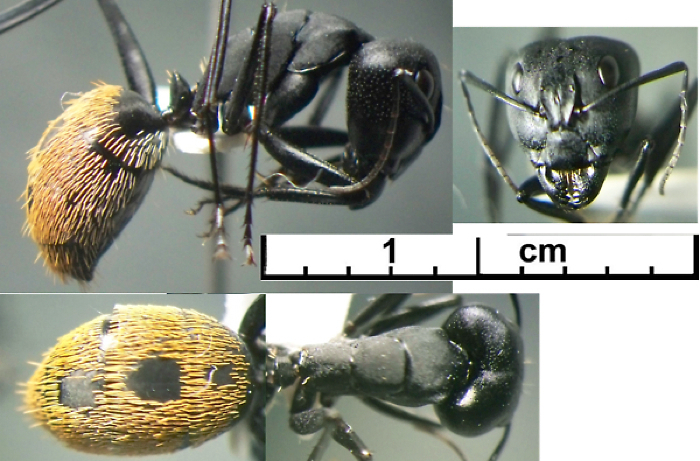 |
| Myrmopsamma Forel (1914a: 261) - all with a very distinctive clypeus, with a posterior third sharply angled downwards into the anterior portion, the angle with a well developed fringe of long hairs (ammochetae); another row of bristles arises on the underside of the head, behind the mouth, and the mandibles also have bristles. Two species, both from sandy areas of southern Africa. One with major TL 13.5-15 mm, other TL 7 mm | 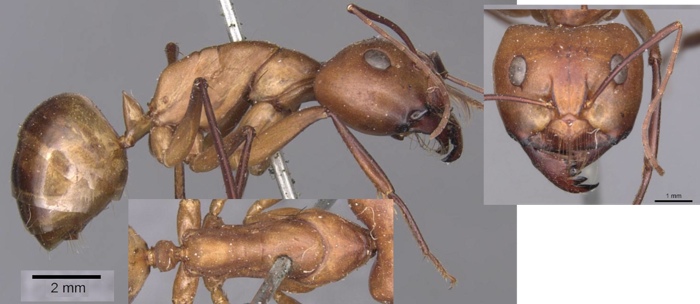 |
| Myrmosaga Forel (1912i: 92) - dorsum of propodeum concave "saddle-shaped", rest of alitrunk convex not margined; smallish, most shining; rather like Tanaemyrmex but more robust; clypeus carinate with short anterior lobe, mandibles usually with six teeth; petiole node variable from squamose to nodiform; gaster lacking pubescence. Eight species from eastern & southern Africa. All medium sized; majors TL to 8.5 mm; minors TL 4.8-5.5 mm (one species TL 7.1 mm) |  |
| Myrmosaga
minor |
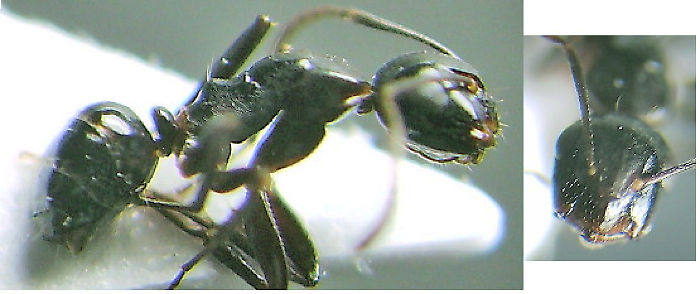 |
| Myrmosericus
Forel (1912i: 91) - with silky appearance, most with a pubescent fleece
on the gaster; clypeus carinate, with pronounced anterior, usually
rectangular, lobe (as Tanaemyrmex); petiole narrowly nodiform;
integument entirely opaque; very finely sculptured, silky and more or
less covered with rather abundant pilosity, especially the gaster; nest
in earth or sand. Minors with elongated heads, in some cases highly elongated. Eleven species known. Majors TL to 10-11 mm; minors TL 6.0-8.0 mm (one or two species smaller) |
 |
| Myrmotrema Forel (1912i: 91) - head as in Orthonotomyrmex, major very broad posteriorly, minor trapezoidal, broadened posteriorly; alitrunk with or without dorsal notch; in major and queen anterior of head covered with deep round pits; gaster at least sparsely pubescent. Thirty-one species known. Most medium sized with largest majors TL 10-11 mm; minors 4.0-6.0 mm |  |
| Myrmoxygenys Emery (1925b: 70) - monotypic (Camp. caesar) and monomorphic, with large worker only, TL 13-14.5 mm; head widest anteriorly, rounded posterior of the eyes in an ogee curve; narrow posterior articulation; mandibles with five teeth, the apical tooth elongated and sharp; gaster with very sparse pubescence. | 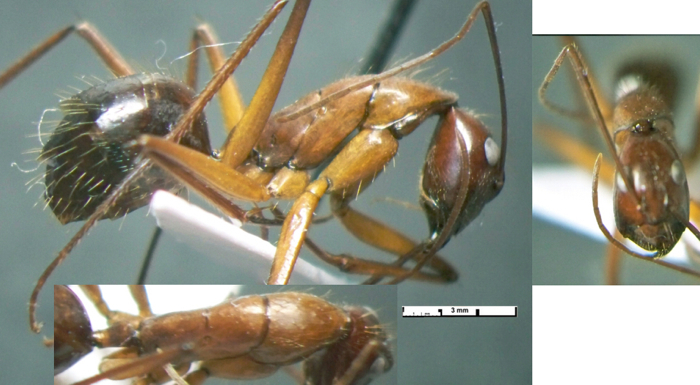 |
| Orthonotomyrmex Ashmead (1906: 31) - as a rule of a heavy build, with opaque integument, sometimes silky or with a few short, coarse, obtuse hairs; gaster with sparse to dense pubescence. Head of major very broad posteriorly. Head of minor trapezoidal, broadened behind. Clypeus short with or without median lobe. Pronotum variably margined; dorsum of thorax usually with metanotal groove, in the form of a notch, sometimes reduced to a deep line; propodeum margined on sides and behind, sometimes rounded. Petiole node squamiform or nodiform, summit always smooth edged. Eight species known, most from eastern/southern Africa. Majors TL ca 10 mm, minors ca 5.5-6.0 mm | 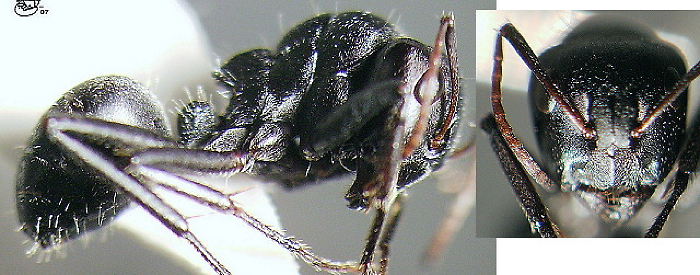 |
| Paramyrmamblys Santschi (1926c: 604) - apparently major with truncated posterior to head; clypeus usually trapezoidal or convex, variably carinate, with anterior border arcuate, rarely with a median impression; alitrunk narrowed posteriorly and with a continuous profile, arcuate or straight, the propodeum not saddle-shaped; declivity of propodeum abrupt. Seventeen species most from eastern/southern Africa. Most with size range TL 5.0-7.0 mm; one species with major TL ca 11.0 mm | 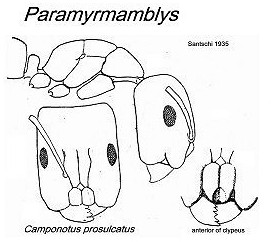 |
| Paramyrmamblys
minor |
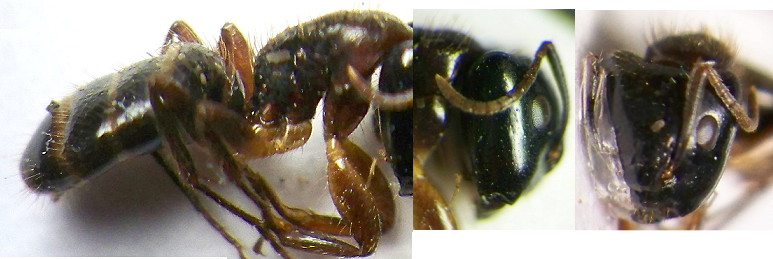 |
| Tanaemyrmex Ashmead (1905b: 384) - member species regarded as in Myrmoturba by Wheeler (1922); synonymized by Emery (1925b: 75) - clypeus carinate, with pronounced anterior median lobe (usually rectangular); gaster with no more than very sparse pubescence. Head of major usually much wider posteriorly, occiput usually without a border; mandibles usually with 6-7 teeth; thorax dorsum arcuate, rarely with propodeum slightly depressed and saddle-shaped. Minors separable into three or more groups - head with parallel sides, heads narrowed posteriorly; heads posteriorly reduced to a narrow articulation or neck; Usually nesting in ground or under stones (truly global with very many species). Fifty-eight species are separated but the confused state of, e.g. maculatus "varieties", probably means there are several more definable species. Size range from medium sized, with major TL to 10 mm, to very large majors with TL 22 mm plus |  |
| Tanaemyrmex
minor |
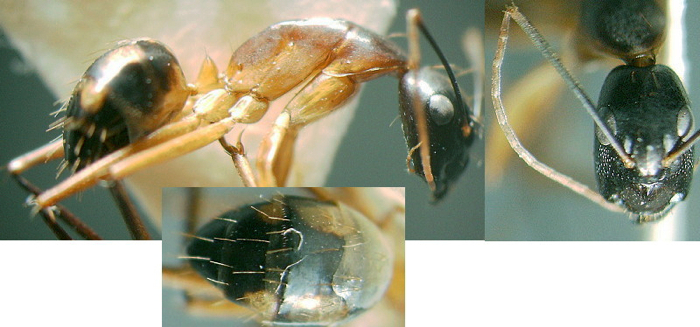 |
| Subfamily Formicinae |
© 2007, 2009, 2011, 2013, 2017 - Brian Taylor CBiol FRSB FRES 11, Grazingfield, Wilford, Nottingham, NG11 7FN, U.K. |
href="camponotus.htm"